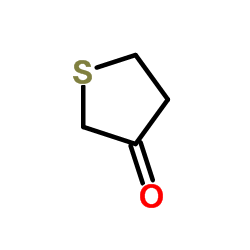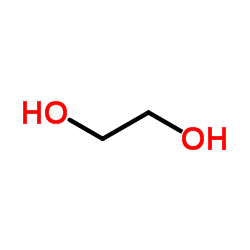1,4-Dioxa-7-thiaspiro[4.4]nonane
Modify Date: 2025-08-27 18:49:32
![1,4-Dioxa-7-thiaspiro[4.4]nonane Structure](https://image.chemsrc.com/caspic/216/176-35-2.png)
1,4-Dioxa-7-thiaspiro[4.4]nonane structure
|
Common Name | 1,4-Dioxa-7-thiaspiro[4.4]nonane | ||
|---|---|---|---|---|
| CAS Number | 176-35-2 | Molecular Weight | 146.20700 | |
| Density | 1.24g/cm3 | Boiling Point | 244.7ºC at 760mmHg | |
| Molecular Formula | C6H10O2S | Melting Point | N/A | |
| MSDS | N/A | Flash Point | 101.8℃ | |
| Name | 1,4-Dioxa-7-thiaspiro[4.4]nonane |
|---|---|
| Synonym | More Synonyms |
| Density | 1.24g/cm3 |
|---|---|
| Boiling Point | 244.7ºC at 760mmHg |
| Molecular Formula | C6H10O2S |
| Molecular Weight | 146.20700 |
| Flash Point | 101.8℃ |
| Exact Mass | 146.04000 |
| PSA | 43.76000 |
| LogP | 0.86640 |
| Vapour Pressure | 0.0468mmHg at 25°C |
| Index of Refraction | 1.546 |
| InChIKey | RQALKBLYTUKBFV-UHFFFAOYSA-N |
| SMILES | C1COC2(CCSC2)O1 |
Synonym:Tetrahydrothiophene-3-one ethyleneketa Section 2 - COMPOSITION, INFORMATION ON INGREDIENTS
Risk Phrases: None Listed. Section 3 - HAZARDS IDENTIFICATION EMERGENCY OVERVIEW
Not available. Potential Health Effects Eye: May cause eye irritation. Skin: May cause skin irritation. May be harmful if absorbed through the skin. Ingestion: May cause irritation of the digestive tract. May be harmful if swallowed. Inhalation: May cause respiratory tract irritation. May be harmful if inhaled. Chronic: Not available. Section 4 - FIRST AID MEASURES Eyes: Flush eyes with plenty of water for at least 15 minutes, occasionally lifting the upper and lower eyelids. Get medical aid. Skin: Get medical aid. Flush skin with plenty of water for at least 15 minutes while removing contaminated clothing and shoes. Ingestion: Get medical aid. Wash mouth out with water. Inhalation: Remove from exposure and move to fresh air immediately. Notes to Physician: Treat symptomatically and supportively. Section 5 - FIRE FIGHTING MEASURES General Information: As in any fire, wear a self-contained breathing apparatus in pressure-demand, MSHA/NIOSH (approved or equivalent), and full protective gear. Extinguishing Media: Use water spray, dry chemical, carbon dioxide, or chemical foam. Section 6 - ACCIDENTAL RELEASE MEASURES General Information: Use proper personal protective equipment as indicated in Section 8. Spills/Leaks: Absorb spill with inert material (e.g. vermiculite, sand or earth), then place in suitable container. Vacuum or sweep up material and place into a suitable disposal container. Section 7 - HANDLING and STORAGE Handling: Avoid breathing dust, vapor, mist, or gas. Avoid contact with skin and eyes. Storage: Store in a cool, dry place. Store in a tightly closed container. Section 8 - EXPOSURE CONTROLS, PERSONAL PROTECTION Engineering Controls: Use adequate ventilation to keep airborne concentrations low. Exposure Limits CAS# 176-35-2: Personal Protective Equipment Eyes: Not available. Skin: Wear appropriate protective gloves to prevent skin exposure. Clothing: Wear appropriate protective clothing to prevent skin exposure. Respirators: Follow the OSHA respirator regulations found in 29 CFR 1910.134 or European Standard EN 149. Use a NIOSH/MSHA or European Standard EN 149 approved respirator if exposure limits are exceeded or if irritation or other symptoms are experienced. Section 9 - PHYSICAL AND CHEMICAL PROPERTIES Physical State: Solid or liquid Color: Not available. Odor: stench pH: Not available. Vapor Pressure: Not available. Viscosity: Not available. Boiling Point: Not available. Freezing/Melting Point: Not available. Autoignition Temperature: Not available. Flash Point: Not available. Explosion Limits, lower: Not available. Explosion Limits, upper: Not available. Decomposition Temperature: Solubility in water: Specific Gravity/Density: Molecular Formula: C6H10O2S Molecular Weight: 146 Section 10 - STABILITY AND REACTIVITY Chemical Stability: Not available. Conditions to Avoid: Incompatible materials. Incompatibilities with Other Materials: Oxidizing agents. Hazardous Decomposition Products: Carbon monoxide, oxides of sulfur, carbon dioxide. Hazardous Polymerization: Has not been reported Section 11 - TOXICOLOGICAL INFORMATION RTECS#: CAS# 176-35-2 unlisted. LD50/LC50: Not available. Carcinogenicity: 1,4-Dioxa-7-thiaspiro[4.4]nonane - Not listed by ACGIH, IARC, or NTP. Section 12 - ECOLOGICAL INFORMATION Section 13 - DISPOSAL CONSIDERATIONS Dispose of in a manner consistent with federal, state, and local regulations. Section 14 - TRANSPORT INFORMATION IATA No information available. IMO No information available. RID/ADR No information available. Section 15 - REGULATORY INFORMATION European/International Regulations European Labeling in Accordance with EC Directives Hazard Symbols: Not available. Risk Phrases: Safety Phrases: S 24/25 Avoid contact with skin and eyes. WGK (Water Danger/Protection) CAS# 176-35-2: No information available. Canada None of the chemicals in this product are listed on the DSL/NDSL list. CAS# 176-35-2 is not listed on Canada's Ingredient Disclosure List. US FEDERAL TSCA CAS# 176-35-2 is not listed on the TSCA inventory. It is for research and development use only. SECTION 16 - ADDITIONAL INFORMATION N/A |
| Safety Phrases | S24/25 |
|---|
|
~73% ![1,4-Dioxa-7-thiaspiro[4.4]nonane Structure](https://image.chemsrc.com/caspic/216/176-35-2.png)
1,4-Dioxa-7-thi... CAS#:176-35-2 |
| Literature: Miklos, Peter; Senning, Alexander Tetrahedron, 1987 , vol. 43, # 1 p. 249 - 254 |
|
~% ![1,4-Dioxa-7-thiaspiro[4.4]nonane Structure](https://image.chemsrc.com/caspic/216/176-35-2.png)
1,4-Dioxa-7-thi... CAS#:176-35-2 |
| Literature: Nagasawa, Kazuo; Umezawa, Toshiyuki; Itoh, Kei-ichi Heterocycles, 1984 , vol. 21, # 2 p. 463 |
| Precursor 3 | |
|---|---|
| DownStream 0 | |
| 1,4-dioxa-7-thiaspiro[4.4]nonane |


![1,4-dioxa-6-thiaspiro[4.4]nonane S-oxide structure](https://image.chemsrc.com/caspic/071/110431-53-3.png)